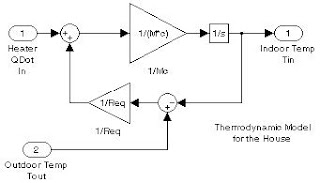1 Start MATLAB. See yourMATLAB documentation if you’re not sure how to do this.
2 Run the demo model by typing thermo in the MATLAB command window. This command starts up Simulink and creates amodel window that contains this model.
When you open the model, Simulink opens a Scope block containing two plots labeled Indoor vs. Outdoor Temp and Heat Cost ($), respectively. 3 To start the simulation, pull down the Simulation menu and choose th Start command (or, on Microsoft Windows, press the Start button on the Simulink toolbar). As the simulation runs, the indoor and outdoor temperatures appear in the Indoor vs. Outdoor Temp plot and the cumulative heating cost appears in the Heat Cost ($) plot.
4 To stop the simulation, choose the Stop command from the Simulation menu (or press the Pause button on the toolbar). If you want to explore other parts of the model, look over the suggestions in “Some Things to Try”
5 When you’re finished running the simulation, close the model by choosing Close from the File menu.
Description of the Demo In Simulink
The demo models the thermodynamics of a house using a simple model. The thermostat is set to 70 degrees Fahrenheit and is affected by the outsid temperature, which varies by applying a sine wave with amplitude of 15 degrees to a base temperature of 50 degrees. This simulates daily temperature fluctuations. The model uses subsystems to simplify the model diagram and create reusable systems. A subsystem is a group of blocks that is represented by a Subsystem block. Thismodel contains five subsystems: one named Thermostat, one named House, and three Temp Convert subsystems (two convert Fahrenheit to
Celsius, one converts Celsius to Fahrenheit). The internal and external temperatures are fed into the House subsystem, which updates the internal temperature. Double-click on the House block to see the underlying blocks in that subsystem

 House subsystem
House subsystem
Hi,Diverting traffic to Web Design Cochin site could both be a daunting task and at the same time easy. With many SEO services.Thanks.....
ReplyDelete